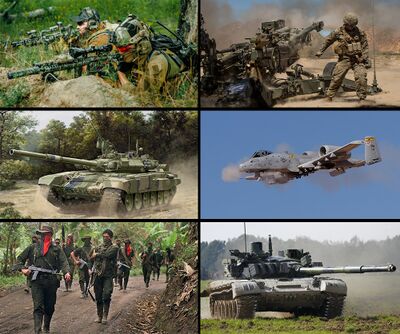Gonzalez Isle Civil War
This article is incomplete because it is pending further input from participants, or it is a work-in-progress by one author. Please comment on this article's talk page to share your input, comments and questions. Note: To contribute to this article, you may need to seek help from the author(s) of this page. |
The Gonzalez Isle Civil War (Spanish: Guerra Civil Gonzalez Isla), more commonly known as The Isle War (Spanish: La Guerra de Islas) or simply The War (Spanish: La Guerra), was a civil war that took place in Gonzalez Isle, an archipelago 623 miles (1002.62km) northwest of the coast of Torisakia and a Torisakia protectorate territory. The war was caused by a combination of social and political factors, notably the failed passing of the Gonzalez Isle independence referendum in 2013 and the political turmoil within Torisakia in 2014 and 2015. It is the deadliest conflict within Torisakia or its territories since the Torisakian Revolution. The war resulted in the signing of the Reuben Doctrine on December 20, 2019, whereby Gonzalez Isle remained a territory of Torisakia and many of the Nationalist factions disbanding.
Background
While the beginnings of the war can be traced back to at least 1973 when Torisakia annexed Gonzalez Isle from Narsora, most experts agree that the war began to rise after the July 2013 Gonzalez Isle independence referendum in which Gonzalez Isle citizens were given the option to vote on whether Gonzalez Isle should be an independent country or not, in which the "No" side won handily with 2,179,242 (69.4%) voting against independence and 964,585 (30.6%) voting for independence. In August 2013, Gonzalez Isle nationalist and former seat-holder for Gonzalez Isle in the Torisakia senate Nicolás Núñez sent a series of ultimatums to then Torisakia president Johnson Crandall, stating that refusal to give the territory their independence would result in the death of "millions" of Torisakians. After Crandall dismissed the ultimatums and condemned Núñez, he began work on honoring his word. On September 26, 2013, supporters of a Gonzalez Isle based political party, called "Los Nacionales" (English: The Nationals), carried out a terrorist attack on the town of Paleto Bay in the Tokai city district, which was the hometown of Crandall. Armed with rifles and explosives, The Nationals attacked the town and killed 26 people and injured nearly a hundred others, before attempting to escape via helicopter but getting shot down by the Torisakia Air Force. Torisakian officials were quick to blame Núñez as the mastermind of the attack, although Núñez would not claim responsiblity for the attack until nearly a year later.
In December 2013, building off what Núñez saw as a "success" with the Palteo Bay attack, The Nationals attempted a coup d'état against the Torisakia government in Gonzalez Isle. Armed with rifles, they attempted to storm the Capital House in Gonzalez Isle City and assassinate governor Lian Esquibel, however the coup failed in only a few hours after The Nationals were subdued by the Gonzalez Isle Defense Force. Many members of The Nationals were arrested and incarcerated afterwards. During the plan of the coup, Núñez met León Ureña, the de facto leader of The Nationals. Together, Núñez and Ureña formed an off-shoot of The Nationals that would focus on committing terrorism and paramilitary operations called the "Blue Gods of Death", which would later be renamed the FEMOINGOLS (Federation for the Movement of Independence of Gonzalez Isle). The Blue Gods of Death would lie in secrecy for several months.
On June 29, 2014, Torisakian Independence Day, the Blue Gods of Death finally made their prescence known to the public when two car bombs were set off on Troutwood Boulevard in Douglas-La Pryor, killing 27 people and injuring 53 others. Núñez claimed responsibility for the attacks not long after, and reiterated his statement that the Torisakian government's refusal to give Gonzalez Isle its independence would lead to the deaths of "millions" of Torisakians, although this time directed at then president Rosalind Dupond.
